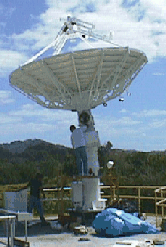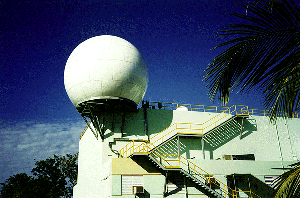
|
FUSE
|
Mission Status Report
|

Mission Status Report #17 Star Date: September 7, 1999
NOTE: Mission Status Reports on the web page will continue roughly once a week, as
events unfold.
-- Bill Blair


Two views of the FUSE ground station in Puerto Rico.
(Click either image to see larger version.)
UPRM Back Up and Running!
FUSE In-Orbit Checkout continued this week, with some real progress, but some
frustrating problems as well. Such is life when your telescope is 480 miles up!
First of all, our ground station in Puerto Rico is back up and functioning normally,
thanks to some hard work by AlliedSignal technicians on site. Swapping out some
hard drives and reinstalling software got rid of the intermittant problems
that had plagued us for two weeks. This is a tremendous step toward getting us
back on track.
In addition, late this last week we saw the (apparently) successful conclusion to
testing of workarounds for several problems we have had in performing
target acquisitions (that is, finding objects we want to observe and "locking
on" to guide stars in the surrounding region). Not only were these tests successful,
but the procedures that perform the workarounds have been automated so that the
spacecraft can detect the problems when they occur, fix them, and continue
operations! This is a HUGE step forward for us, since we have been very much
locked into doing things only when we had real time contacts through the ground
station (so we could watch what was going on). Our enthusiasm is tempered only
by the fact that we need further testing and use of the system to tell us if
the changes are robust.
On the down side, we have tried several times over the last week (before the above
fixes were in place) to perform a test that would allow us to roughly align all
four of FUSE's mirrors. Each time this test failed due to one or more of the
problems described above and in previous reports. One of the reasons we tried so hard
to do this last week was that we had appropriate objects in the continuous viewing
zone (the portion of the orbit that can be observed all the time), making
scheduling of the test relatively easy and efficient. However, this zone moves
on the sky, and the targets are no longer available without periods of occultation
(that is, where they get blocked for a portion of the orbit by the earth).
So we'll have to do this test the hard way now.
A new problem has reared its head this week and is now the most significant
problem for ongoing operations: the memory in the Instrument Data System
(IDS, or instrument computer) has become fragmented. A "feature" in our
uplink system leaves little pieces of "trapped" memory that, over time,
limit the contiguous blocks of memory that are available. In normal operations,
this wouldn't be a significant problem, but because of the non-standard way we have
been operating, thousands and thousands of commands have been sent up over
the past two months, leaving us with this problem. Lacking a space-qualified
version of "Norton's Disk Doctor", the only option appears to be that we must
reboot the IDS computer. This is disruptive because the IDS does all sorts
of things, like maintaining the thermal control of the telescope and managing
the high voltage control on the detectors. So by rebooting the IDS, we have
to perform a lot of other "clean-up" work to get back on track. This will take
about a day next week. The good news here is that the reason for this fragmentation
is understood and a fix will be included in a new IDS code load that is planned
for later this month.
Despite this litany, the mood here on the project is upbeat.
We have met each problem head on, and have made significant progress toward
getting FUSE ready for normal science operations. And we are all looking forward
to seeing that first spectrum through all four aligned channels!!
Reported by: Bill Blair, Chief of Mission Planning

|